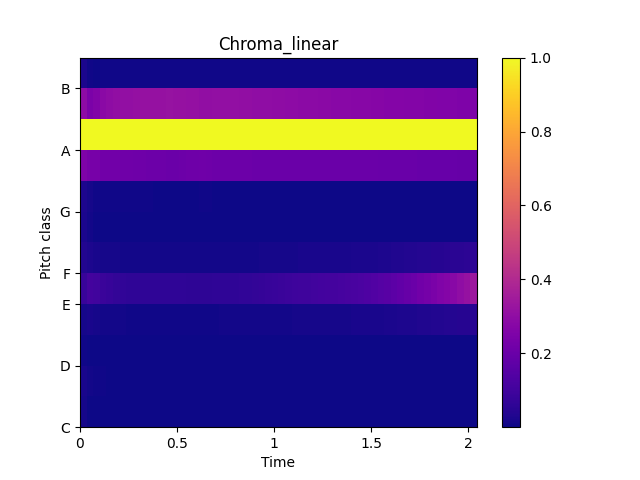audioflux.chroma_linear
- audioflux.chroma_linear(X, chroma_num=12, radix2_exp=12, samplate=32000, low_fre=0.0, high_fre=16000.0, window_type=WindowType.HANN, slide_length=1024, data_type=SpectralDataType.POWER, style_type=SpectralFilterBankStyleType.SLANEY, normal_type=SpectralFilterBankNormalType.NONE)
Linear(STFT) chromagram
- Parameters
- X: np.ndarray [shape=(…, n)]
audio time series.
- chroma_num: int
Number of chroma bins to generate.
- radix2_exp: int
fft_length=2**radix2_exp- samplate: int:
Sampling rate of the incoming audio.
- low_fre: float
Lowest frequency.
- high_fre: float or None
Highest frequency. Default is 16000(samplate/2).
- window_type: WindowType
Window type for each frame.
See:
type.WindowType- slide_length: int
Window sliding length.
- data_type: SpectralDataType
Spectrogram data type.
- style_type: SpectralFilterBankStyleType
Spectral filter bank style type. It determines the bank type of window.
- normal_type: SpectralFilterBankNormalType
Spectral filter normal type. It determines the type of normalization.
- Returns
- out: np.ndarray [shape=(…, chroma_num, time)]
The matrix of chroma_linear
See also
Examples
Read 220Hz audio data
>>> import audioflux as af >>> audio_path = af.utils.sample_path('220') >>> audio_arr, sr = af.read(audio_path)
Extract chroma_linear data
>>> chroma_arr = af.chroma_linear(audio_arr, samplate=sr)
Show spectrogram plot
>>> import matplotlib.pyplot as plt >>> from audioflux.display import fill_spec >>> import numpy as np >>> >>> # calculate x-coords >>> audio_len = audio_arr.shape[-1] >>> x_coords = np.linspace(0, audio_len/sr, chroma_arr.shape[-1] + 1) >>> >>> fig, ax = plt.subplots() >>> img = fill_spec(chroma_arr, axes=ax, >>> x_coords=x_coords, >>> x_axis='time', y_axis='chroma', >>> title='Chroma_linear') >>> fig.colorbar(img, ax=ax)
